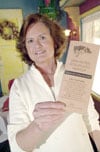Ralph and Martha Edwards sit in a circle beside their daughter, Lilah — a victim. A recently charged juvenile delinquent, with his mother, joins them — an offender.
Larson Newspapers
________________
Ralph and Martha Edwards sit in a circle beside their daughter, Lilah — a victim. A recently charged juvenile delinquent, with his mother, joins them — an offender.
In the same circle sits a “community” of residents, counselors and law enforcement. Lana Leonard, program coordinator of Sedona-Oak Creek Restorative Justice Partnership, facilitates.
Tell your story, Leonard insists.
The young Edwards girl, 14, clears her throat and speaks.
Edwards remembers, in vivid detail, how a fire approached her West Sedona home on July 4, 2005. She remembers a tree igniting while she dialed 9-1-1 in tears.
The juvenile listens to how the fire impacted Edwards, her family and the community. He awaits his turn to speak.
Tell your story, Leonard says to the offender.
The offender begins with an apology, and so begins the process of restorative justice.
Restorative justice is a criminal justice theory that proposes crimes are committed against individuals or communities, not the state. It emphasizes reparation through payment, community service or, often times, both.
In 2002, Leonard began activism to initiate the program locally.
“It has incredibly low recidivism rates. It’s definitely not an easy out,” she says.
Sedona Police Chief Joe Vernier says he supports the concept of restorative justice, yet adds that restorative justice is a volunteer-based program. Police officers can’t make either the victim or offender participate if they refuse.
Leonard describes how SORJ works.
When a nonviolent crime is committed by a juvenile, police have the discretion to refer the victim and offender to SORJ. At that time, if both parties agree, Leonard is called.
Leonard then asks for a “pre-court diversion.” This allows SORJ to take over the case and act as mediator between the victim and offender.
One week before victim and offender meet, victims are asked to think about how they were harmed. Both parties are asked what should happen.
A third party consisting of township members, counselors and law enforcement acts as the “community.” They oversee the circle and ensure mutual respect and
equality.
When the three parties meet again, they hope to resolve the issue and agree on reparations.
According to Leonard, the reparations should play on the offender’s strengths and gifts, similar to a Navajo “peacemaking circle.”
When the offender decides his or her fate, or “punishment,” it is called the “self-sentence.”
“That is the pearl of restorative justice. The wisdom of the circle adjusts the self-sentence to meet everyone’s needs,” Leonard says.
If the issue can’t be resolved within 90 days or the terms of reparations aren’t met in the designated time, the offender returns to conventional methods of criminal justice — court.
In November, a Sedona teenager was taken into custody for theft and underage drinking. The arresting officer referred the teen to SORJ.
“Joe,” the father of the teen, is thankful.
“Restorative justice looks at what can be corrected, what can be achieved in a more positive manner,” he says.
Joe adds that SORJ required his son to be active in the decision-making process.
Currently, the teen abides by family, as well as city, law and is within a half-hour of completing 20 hours community service at the Sedona Recycling Center.
“Now, he’s responsible, receptive and accountable. He’s got a lot of maturing to do still, but he’s getting there,” Joe admits.
“The key factors an offender must have to be a success are empathy and accountability,” Leonard adds.
Restorative justice was a “healing process,” Ralph Edwards says.
At first, he didn’t think the vandalism was significant. The majority of the fire swept into a vacant lot.
Later, he recognized the “ripple effects” that occurred due to the accidental fire. The entire community became involved with the flick of a match, literally.
Restorative justice was the perfect way for his daughter to find closure to a traumatic episode, Edwards says.
“He’s a nice kid, one of my daughter’s friends,” Edwards says of the offender. “He was just at the wrong place at the wrong time. Restorative justice gave him a way to rectify the situation in a way that was healing for my daughter and him.”
Edwards believes restorative justice is a community-oriented approach to solving problems. It allows offenders to regain self-esteem in addition to a clean slate.
Leonard says SORJ is adapted from the Maori model of cultural justice.
According to Leonard, Maoris require people to “break bread” after the circle ends. The offender, victim and community unite in a partnership.
“Making amends is healthy,” Leonard adds.
Vernier adds he approves of any method where offenders accept consequences for their actions and recognize an obligation to victims.
“Law enforcement is only one approach. Restorative justice is another. We’re trying to work together and have a balanced justice system,” he says.



















